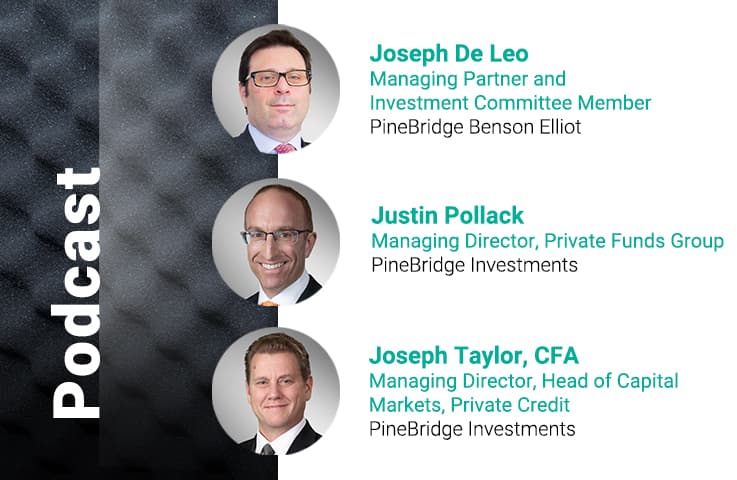Why We Think the Middle Market Can Beat Out Large-Caps in Private Equity Investing

Steven Costabile, CFA
Global Head of Private Funds Group

Justin Pollack
Managing Director, Private Funds Group

Cora Chen, CFA
Senior Analyst, Private Funds Group
We believe middle market transactions, which involve companies with annual EBITDA typically ranging from $5 million to $100 million, are the lifeblood of many industries and a source of attractive return potential for investors, offering some key advantages over larger deals.
In our view, middle market firms are often nimbler and better positioned to adapt swiftly to market changes, capitalize on niche opportunities, and drive value creation through operational enhancements.
These transactions also can provide resiliency amid economic uncertainties, with middle market buyouts generally showing lower correlations with public equity markets relative to large market buyouts.
Middle market companies’ historically lower valuations for acquisitions and generally greater latitude for operational improvements relative to larger companies may offer the opportunity for greater returns on investment.

Middle market buyouts represent a dynamic segment of the private equity landscape that plays a pivotal role in driving economic growth, fostering innovation, and generating attractive returns for investors. Middle market transactions involve companies with annual EBITDA typically ranging from $5 million to $100 million. Unlike mega-deals that garner headlines, middle market buyouts often operate under the radar, yet they are the lifeblood of many industries, from manufacturing and technology to healthcare and consumer goods.
Here we look into the nuances and advantages of middle market buyouts, exploring why these transactions continue to capture the attention of investors and industry observers.
Nimbleness to respond to opportunities
Middle market firms have historically been better positioned to adapt swiftly to market changes, capitalize on niche opportunities, and drive value creation through operational enhancements. These characteristics, coupled with a favorable economic environment, have contributed to the sustained outperformance of middle market buyouts, making them an attractive investment avenue for discerning investors. For the past 10 years, upper-quartile middle market funds posted net internal rates of return (IRRs) that were 719 basis points higher than upper-quartile large-cap funds, per data from Preqin (see chart). That’s the case for the median of fund performance as well.
Middle Market IRRs Have Outpaced Large-Cap Buyout Funds
Middle market IRR outperformance vs. large-cap buyout funds: Vintage 2013-2021

Source: Preqin database, retrieved 20 May 2024. Represents query of pooled net fund returns in Preqin database from new private equity funds closed 1 January 2013 to 31 December 2021 across 568 funds. Net IRR here represents the 75th percentile (1st quartile), 50th percentile (2nd quartile), and 25th percentile (3rd quartile) of self-reported internal rates of return to the limited partners net of all management fees, carried interest, and other fund expenses. PineBridge Private Funds Group investors would have additional fees, which may result in lower returns. For illustrative purposes only. Past performance is not indicative of future results.
Resiliency under economic uncertainties
Compared to the large market buyouts, middle market buyouts have historically shown a lower correlation with the MSCI World public equity market index, and a lower annualized standard deviation. A Preqin article, “US middle-market deals defy economic uncertainties,”1 supports this perspective that mid-market deal activity has demonstrated lower volatility and greater resilience compared to larger deals amid economic uncertainty. The argument is further supported by the pickup of deal activity over the last two years. The market share of US private equity middle market deals increased from 45% of total private equity volume in 2021 to 53%2 in 2023, reflecting the growing quality of middle market companies in the US.
Middle Market Private Equity Shows Lower Correlations With the MSCI World Index vs. Large Market
(2013-2023)

Source: Cambridge Associates, FactSet, and Bloomberg. Based on analyzing the correlation and standard deviation of the returns generated under the middle market, large market, and MSCI World index from 2013 to 2023. Large cap represents commitment size equal to or greater than US$2 billion. Middle market represents commitment size below US$2 billion.
Investors often sort listed equities into three major categories: large capitalization stocks (total equity values above $10 billion), small-cap companies (less than $2 billion of capitalization), and mid-caps, which fall in between.
In the private markets, the PineBridge Private Funds Group (PineBridge) distinguishes a large-cap private market company by drawing a line at $1 billion of enterprise value or EBITDA over $100 million, and we view a pool of capital with over $2 billion of commitments and the ability to invest globally across industries as a large-cap-focused fund. What falls below those figures we broadly define as the middle market.
Further distinctions can help investors observe how differences in the size of investments can lead to considerable variations in strategy – and performance. A split can be made between the upper middle market, which features companies with $100 million to $1 billion of enterprise value, and their smaller peers in the lower middle market. As the size shrinks, a fund manager’s focus typically narrows, but the two portions of the middle market are similar when contrasted with large-cap buyouts.

Provided for illustrative purposes only.
Lower starting valuations
The purchase multiples for buyout investments have been trending up, spurring a rise in enterprise value (EV)-to-EBITDA valuation from 11.4x in 2019 to 12.3x in 2023.3 In line with the market trend, valuation multiples for middle market buyouts with transaction sizes under US$1 billion were between 9.4x and 8.8x last-12-month (LTM) EBITDA in the past five years, which is 36% lower on average than the range of 11.8x to 11.6x for larger companies (see chart below).
The comparatively lower valuation for acquisitions makes middle market buyouts more compelling, as a potentially attractive valuation may offer the opportunity for greater returns on investment. PineBridge believes that the cash flow of portfolio companies plays a pivotal role. If cash flow is the key for servicing substantial leverage in a buyout scenario, then overpaying for large-cap EBITDA puts the leverage strategy at a disadvantage relative to acquiring more affordably priced middle market enterprises, in our view.
Valuation Multiples for Middle Market Buyouts Are Compelling vs. Large-Cap
Implied enterprise value/EBITDA multiples based on transaction size

Source: FactSet as of 31 December 2023. Represents all announced acquisitions globally.
Unequal influence for value-creation strategies
In addition to lower entry valuations, middle market companies have often been more agile and flexible in their operations than large market companies. This agility has allowed private equity firms to implement changes and strategic initiatives more quickly and efficiently, leading to faster value creation. Middle market companies may also have more room for operational improvements and efficiency gains compared to larger companies that have already optimized many of their processes.
Private equity firms can leverage their expertise to streamline operations, reduce costs, and enhance profitability in middle market acquisitions. Strategies such as recruiting experienced management, implementing tighter financial controls, or introducing new products are techniques that may boost the value of a portfolio company whose EBITDA is under $100 million, and the expense of professionalizing these businesses is lower because it is applied against a smaller base of operations. In contrast, a large-cap sponsor cannot expect to make more than incremental enhancements to a newly acquired company’s current business plan, given that capable managers likely already occupy the C-suite.
The Potential Upside Is Generally Higher for Middle Market vs. Large-Cap Buyout Businesses

For illustrative purposes only.
PineBridge believes the lower middle market provides sustained outperformance potential
We believe the factors above help to explain the attractive performance of middle market buyout opportunities since the global financial crisis ended in June 2009. Institutional investors that bypassed the middle market and instead concentrated assets in large-cap opportunities may have missed out on some of the structural advantages of middle market buyouts, which may not have been evident with those larger deals.
PineBridge believes opportunities remain for investors considering the middle market’s fundamental strengths.
The Middle Market Advantage
Private equity market segments have historically provided different levels of attractiveness.
A large and growing opportunity
Buyout funds with less than US$2 billion of capital employ different strategies than funds with higher capitalization.4
Historically, many financial sponsors exerted greater influence on companies with less than US$100 million of EBITDA when compared with large-cap buyout portfolio companies.
Lower valuations and standard deviation
Valuations for global acquisitions of companies with enterprise values of US$1 billion or less averaged 36% lower than for larger companies over the past five years.5
Distinct privately held assets allow middle market private equity to offer a lower correlation to the public markets and lower volatility than large market private equity.6
Strong performance
The top quartile of middle market funds outperformed the top quartile of large-cap funds by 719 basis points since 2013.7
1 Source: Preqin Blog, “US middle-market deals defy economic uncertainties” (C. Rolle, 14 June 2023).
2 Source: Pitchbook Market Report, “PitchBook's 2023 Annual US PE Middle Market Report”
3 Source: Pitchbook Market Report, “PitchBook's 2023 US PE Breakdown”
4 FactSet as of 20 May 2024. Represents all announced acquisitions globally.
5 FactSet as of 31 December 2023. Represents all announced acquisitions globally.
6 Cambridge Associates, FactSet, and Bloomberg. Based on analyzing the correlation and standard deviation of the returns generated under the middle market, large market, and MSCI World index from 2013 to 2023.
7 Preqin database, retrieved 20 May 2024. Represents query of pooled net fund returns in Preqin database from new private equity funds closed 1 January 2013 to 31 December 2021 across 568 funds. Net IRR here represents the 75th percentile (1st quartile), 50th percentile (2nd quartile), and 25th percentile (3rd quartile) of self-reported internal rates of return to the limited partners net of all management fees, carried interest, and other fund expenses. PineBridge Private Funds Group investors would have additional fees, which may result in lower returns. For illustrative purposes only. Past performance is not indicative of future results.
Disclosure
Investing involves risk, including possible loss of principal. The information presented herein is for illustrative purposes only and should not be considered reflective of any particular security, strategy, or investment product. It represents a general assessment of the markets at a specific time and is not a guarantee of future performance results or market movement. This material does not constitute investment, financial, legal, tax, or other advice; investment research or a product of any research department; an offer to sell, or the solicitation of an offer to purchase any security or interest in a fund; or a recommendation for any investment product or strategy. PineBridge Investments is not soliciting or recommending any action based on information in this document. Any opinions, projections, or forward-looking statements expressed herein are solely those of the author, may differ from the views or opinions expressed by other areas of PineBridge Investments, and are only for general informational purposes as of the date indicated. Views may be based on third-party data that has not been independently verified. PineBridge Investments does not approve of or endorse any republication of this material. You are solely responsible for deciding whether any investment product or strategy is appropriate for you based upon your investment goals, financial situation and tolerance for risk.



